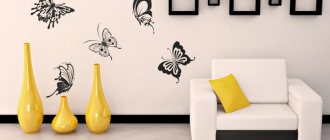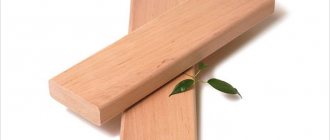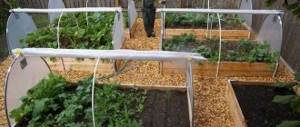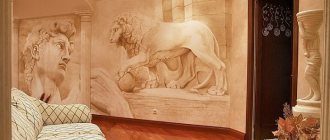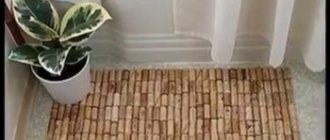What is phytowall
A phytostene (eco-wall) is understood as a special panel with pockets in which plants are planted, mounted on a vertical plane. Simply put, this is a vertical structure designed for interior landscaping. The sizes can be very different - from 50-60 cm to several tens of meters. Phytowalls can be used indoors and outdoors, but most often they are located in the living room, bathroom or office.
Plants on the wall in the living room
The eco-wall looks simply incredible, magnificent, immediately attracting attention. It fills the space with rich color, brightness and a pleasant smell of greenery. In addition, the use of phytowall solves a number of other problems and has many advantages:
- elimination of dirt, dust - plants literally attract flying pollution to themselves, and the air becomes cleaner;
- health benefits - humidity and oxygen saturation are optimized, the microclimate in the house improves;
- comfort in sleep - in oxygen-rich air a person rests better and sleeps more soundly;
- safety - this type of finishing is environmentally friendly, 100% suitable for children's rooms, and perfectly replaces other types of materials;
- zoning of space - with the help of a phytowall you can highlight separate zones in the room, for example, designate a place for rest and relaxation;
- practicality - the phytowall hides all surface defects without taking up extra floor space, you can place the required number of plants on it that would not fit on cabinets or window sills;
- originality - an ordinary wall after placing plants will look like a real carpet or painting;
- combination with different interior styles - phytowall can be used not only in eco-style and country, but also in high-tech, loft, and many other directions.
Using a phytowall in a loft-style interior
You can even build a vegetable garden on the wall.
For example, in the kitchen, a phytowall is planted with spices - parsley, basil, oregano, which can be cut off periodically. As for inedible plants, such a mini-garden usually lives up to 7 years, and dead specimens are easy to replace with new ones.
How long does phytowall “live”?
To a large extent, the duration of suitability of a “green” wall as a decoration is determined by two factors:
- possible age of the vegetation used;
- the degree of wear resistance of the base material - if plastic is used, then it is practically unlimited.
Important! On average, the service life of a phytowall is up to 7 years.
Phytowall designs
To set up a vertical gardening system, a variety of phytowall options are used, which are produced industrially or made on site independently:
- Phyto-module. This is a composition of living plants that has a compact size. If necessary, such a phytowall can be moved to other rooms, since it is fixed with the possibility of easy dismantling. Usually the structure is made of a thin-walled profile with external galvanization, which prevents it from rusting. The phyto-module is an easy option for zoning space; it can be disassembled and assembled without any problems.
- Phyto-picture. The body walls of small phytowalls are quite wide, so they resemble an ordinary picture frame. Phyto-pictures are great for accent decoration of rooms for any purpose. It is better to place them in the most visible place so that they look as beautiful as possible in daylight and evening light.
- Phytoinscriptions. They are a type of painting in the shape of letters. Usually made from green moss that has undergone special treatment.
- Phyto-cabinet. Most often, such a structure is made from MDF. It consists of several separate blocks, which are placed in the desired cell in the furniture itself. There is a plastic tray at the bottom of the cabinet to collect moisture.
- Stepped phyto-modules or boxes. Such devices are attached to the wall with self-tapping screws or hung from hooks. Most often they are created from durable polyvinyl chloride with ready-made cells. For watering, a drip system with an electric motor is connected to the boxes, which itself pumps water into the cells. In advanced versions, humidity sensors are built into the system.
- Green wall, or classic phytowall. This is a large-scale composition consisting of many compartments. They are planted with live plants or artificial “seedlings” or moss are attached. Designers advise sticking to brevity when decorating the rest of the interior, because the phytowall will serve as the brightest accent in the room.
Container vertical gardening system
What plants are used for phytowalls
Phytowalls can be made in different shades, which is why this type of vertical gardening can fit into almost any interior.
Types of plants that are used for phytowalls:
- Stabilized moss. Maintenance of living decorations is minimal: it just needs to be wiped periodically to remove dust. But, unfortunately, moss is not capable of purifying the air and improving the environment.
- Natural plants. Of course, they need more careful care, but it's worth it. A phytowall made from natural plants purifies the air. In addition, it reduces stress levels and absorbs noise. Plants also process sweat, furniture evaporation, skin and hair particles. Therefore, such phytowall will have a good effect on human health.
Vertical gardening is also created from dried flowers and artificial plants, but much less frequently. They are used exclusively for decorative purposes.
The use of phytowalls in apartments and offices
It has long been proven that the presence of plants in offices helps to create a favorable microclimate and optimize the work environment, helping to relax during breaks. A phytowall in an office will decorate the interior, attract clients, make employees have a positive attitude and become a real calling card of the company.
Vertical green installations look chic in the interior of a house or apartment and are especially suitable for eco-style. Even in a small room you can use small-sized eco-modules, for example, lining the area behind the head of the bed with greenery. Phytowalls also look good in the bathroom, toilet, and kitchen. They are ideal for rooms without windows, increasing a person’s psychological comfort.
Bathroom with vertical gardening
A phytowall will help divide the room into several zones, which perform different tasks in a large space. For example, with its help you can set up a cozy gazebo, closed from prying eyes, right in your apartment. Phyto-modules of radius shape decorate the columns, which looks very bright and attractive. Small products can play the role of phyto-paintings, which are mounted on walls even in tiny rooms.
Phytowall - DIY production for the interior of a house or apartment
You probably already know that a phytowall can be a wonderful decoration for your home, if, of course, it is placed and made correctly. So, for example, if you live in a small apartment, then it is best for you not to make a bulky vertical garden. In this case, the phytowall will really cover the entire wall, then it will look a little alien. But for large houses, you can give free rein to your imagination and make large and bulky vertical gardens.
It can be placed in the hallway, kitchen, living room, and some are even installed in the bathroom! True, when creating such a finish, you will definitely need to take into account for what purposes you will use the vertical garden. If you have a goal to use it to perform zoning, then you should make a portable module that, if necessary, can be easily moved to the side or simply moved to another place. If you want the phytowall to be used as an indoor air purifier, and it will also be located in the same place, then you should definitely make a stationary phytomodule that will be connected to the sewer system and connected to a special system for irrigation. Yes, such a module will be more difficult to make, but in the end it will be much easier for you to care for the plants that you plan to plant.
There are some great ideas for your home:
- Fistena in the form of a painting (living painting). This type of landscaping is suitable for living space, namely for bedrooms, hallways and small living rooms. As a rule, in this case, the phytowall module is placed in the most visible place and so that it looks as beautiful as possible both in daylight and even in artificial light.
- Phytowall for zoning living space. This type of vertical green garden is perfect for creating cozy areas where you can sit alone and hide from prying eyes. With the help of such a green wall, you can create a hidden dining area where the living room is located, or create an intimate corner on the bedroom wall and feel like the first people on the planet - Adam and Eve. True, even in this case you will need to remember the dimensions of the room. The smaller the room in which the phytowall is located, the more airy the garden should be.
- Phytowall for large landscaping. In this case, you can afford to place plants on one, and possibly two walls at once. But remember that in order for the phytowall to ultimately fit perfectly into the overall design of the room, the interior must be laconic in all respects.
This will mean that the ceiling and remaining walls should have a fairly simple and calm finish. If they also attract attention, it is unlikely that you will be able to make your living space truly cozy.
Plants for phytowalls
Most indoor plants are suitable for making phytowalls, although there are some peculiarities in their use. It is necessary to select the most unpretentious species that do not require too much light and water. It is better to use either green or flowering plants on one phytowall, otherwise the harmonious appearance of the decor will be disrupted. This rule does not exclude accent decoration of the phytowall with flowers.
To set up a vertical gardening system, you should select only those plants that do not cause allergic reactions. It is advisable that they do not have a smell, because it will gradually begin to irritate the residents or even cause a headache. Plants with a long life expectancy are considered ideal, which will increase the service life of the phytowall itself. Among the green plants, the best choices are the following:
- tradescantia;
- ferns;
- chlorophytum;
- ivy.
Hedera or indoor ivy is well suited for hanging.
These plants are most often used to create the main background of a phytowall. Orchids, phytonias, and pileas can become bright accents of the design.
Moss for phytowalls
Moss is ideal for those who plan to build a phytowall themselves. It is unpretentious, loves shade, and does not require fertilization. In addition, moss seriously improves the sound insulation of walls, so you can forget about noise from neighboring apartments. Most often, moss moss is used for vertical gardening, which is subjected to special treatment. The moss is first preserved by wetting it with special solutions, painted to add brightness, and protective compounds are applied to prevent rotting and mold growth.
Greening walls with moss
At home, you can use ordinary forest moss even without pre-treatment, but maintenance in this case will be more difficult, and individual areas will have to be replaced periodically.
Stabilized moss is glued onto MDF panels, since it does not need soil to grow. Unfortunately, it does not have any particular benefit for the body and serves only a decorative role.
Flowers on the phytowall
If you decide to install a phytowall with flowering plants, you need to select color compositions that harmoniously combine with each other in advance. Red and white flowers on a green background look very impressive (for example, spathiphyllum and anthurium, the flowers of which have a similar shape and appearance). Landscaping systems with begonias, violets, and Schlumbergera cactus look great. Caring for such plants must be very careful, otherwise they will not bloom and may die. If orchids are chosen for the phytowall, they will have to create a separate irrigation and lighting system.
Blooming spathiphyllum on the wall
Artificial plants
Allergy sufferers and people who do not have enough time to water and replant living plants often choose a phytomodule made from artificial elements. The same thing should be done if there are animals in the house, during long absences, when there is no one to take care of the plants. Artificial greenery is durable, safe, does not emit odors, and looks lifelike. There are special plant blocks for sale for phytomodules, which will be easy to build yourself.
Phytomodules from artificial plants
Grass
To make the phytowall look like a flat football field, you can plant regular lawn grass, cereals, and wheat sprouts on it. A phytomodule made from herbs is perfect for the kitchen:
- mint;
- sage;
- cilantro;
- parsley;
- caraway;
- basilica;
- lemon balm.
Vertical gardening with herbs
The best plants for phytowalls
Which plant families are suitable for “settling” on a phytowall? A good option would be representatives of the Marantaceae - low bushy plants that do not like frequent watering and grow in the shade without any problems. Representatives of the Hypoxidium family are distinguished by longer leaves and low height and are well suited for the outermost modules of phytowalls.
Ferns - pteris, pellea, nephrolepis - give a lush top that looks very airy and beautiful. Such plants do not die even close to heating sources and do not require much solar energy. Bromeliads are flowering plants, but you don’t need to water them, but simply spray them with a spray bottle - this is enough for life, growth and an attractive appearance.
Fern phytowall in a cafe
According to experts, ivy varieties are best suited for phytomodules. They will not die even with a severe lack of water, light, or air, so they can be used in rooms without windows. Thanks to the wide variety of ivy, you can build an original phytowall from them.
Plant selection
When choosing a particular plant for a given decorative element, you should take into account the conditions in which they will be kept, as well as how you can care for them.
Live indoor plants
Approximately 40 plants can be placed on one m2. This amount of them has a positive effect on the climate in the house or apartment. In addition, they can be placed in any public interior, the main thing is that the phytostructures in which they are planted have an automatic watering system.
Stabilized plants
They are natural and do not require care, watering, light or additional equipment, and do not grow. This is an excellent solution for creating a wall in a public place, any commercial space such as an office or hotel. In addition, they are great for walls in a residential apartment, house, sauna, for example, if you need to reproduce a pattern from plants. In such conditions, the use of stabilized moss and plants is considered an ideal solution.
Stabilized flowers are not artificial plants or dried flowers. These are natural plants in which, as a result of special processing, the natural juice is replaced by an unusual solution based on glycerin. The technology makes it possible to subject all crops used by florists to such treatment, while the stabilized materials have strength and elasticity, and their appearance is no different from natural ones.
Today, the following types of moss are often used for projects:
- green moss tussocks;
- green moss in layers;
- Scandinavian colored moss.
The advantages of stabilized crops include:
- beauty, naturalness and bright appearance;
- wider range of uses in finished products;
- lack of essential care for them - they do not need to be constantly watered, do not require lighting, and are not susceptible to diseases;
- easy to store and transport - there are no restrictions on temperature conditions and storage periods;
- absence of seasonality factor;
- environmental friendliness - do not pollute the environment and are harmless to people and animals;
- color stability, long time;
- long shelf life for many years.
What kind of care is needed? In order for plants and compositions made from them to delight you with natural freshness for as long as possible, you should follow a few simple rules for handling them: avoid getting liquid on the leaves or in flowerpots and do not store them in rooms with high humidity (saunas, baths, swimming pools). A humidity range of 60 to 80 percent is optimal, and sudden changes in temperature should be avoided. The recommended temperature for stabilized flowers ranges from +5 to +35 degrees. It is necessary to avoid excessive dryness of the premises and direct sunlight into the module to prevent premature drying of the plantings.
Artificial plants
Artificial options are more suitable for decorating various events: exhibitions, presentations, conferences, meetings, corporate events and other special occasions. Such a module does not require any maintenance at all, can be disassembled and stored anywhere, used from time to time.
Do-it-yourself phytowall and phytomodule
Not everyone can buy ready-made phytowall, because its price is quite high. But if you have the desire and patience, there is a chance to make the design yourself.
Beginning of work
The first step is to decide where exactly the phytowall will be located and accurately determine its boundaries in the room. Next, you should choose vegetation that suits all parameters well and think over the design. It is advisable to sketch the future phytowall on paper to make its installation easier. Also, if necessary, you need to indicate the position of additional decor if it is also planned in the design.
Rules for collecting eco-module
An important condition for the existence of a phytowall is that there is no danger of getting the very base—the wall in the room—wet. Usually a special waterproofing layer is laid on the inside of the module. If the phytowall has a solid metal or plastic frame, then waterproofing is not required.
Important rules for arranging a phytowall are as follows:
- if possible, light sources should be located as close to the plants as possible;
- Before starting work, you need to carefully outline the base down to the individual compartments - this will help to carry out installation with high accuracy.
Plant fabric pockets
Ideas for additional decor
A phytowall equipped with lighting will look even more attractive. For this purpose, you can use both regular and colored light bulbs, which create interesting visual effects. Glass baguettes, small waterfalls, mirrors, shells, and stones are often used as decor for phytowalls.
Tools and materials for manufacturing
Before assembly, you need to pay attention to preparing the frame. It will require boards or slats, a plastic or metal profile, aluminum corners or PVC pipes. An aluminum frame is not suitable for the manufacture of large, heavy phytomodules, since there is a risk of it sagging.
You will also need a piece of waterproof fabric that will prevent moisture from seeping through. The cheapest option is polyethylene, but it will interfere with natural air circulation and cause mold. Therefore, instead of polyethylene, it is better to take polypropylene, membrane or PVC fabric. Cells for plants should also be made of rot-resistant material (a special type of felt). In addition, you need to prepare:
- a tube for drip irrigation with a plug and a hose;
- an aquarium-type submersible pump for pumping water (for each meter of phytowall you need to take a pump with 1.5 meters of liquid rise);
- drip tray;
- soil - expanded clay or hydroponics, or sphagnum moss, which perfectly absorbs and retains water.
Felt-type phytomodule design
Also needed for work are tools and consumables - a construction stapler, ruler, pencil, scissors, screws, drill.
Assembly and installation of an eco-wall
The frame must be assembled according to the required size, secured with screws. Next you should do the following:
- sew the fabric with pockets, process the seams so that the edges do not unravel;
- use a stapler to attach the canvas to the frame, carefully pulling it on all sides;
- secure the module to the wall with screws, leaving a distance of about 2 cm so as not to disturb the ventilation;
- Place a PVC pipe for irrigation between the profile and the fabric at the top, closing it with a plug on one side;
- make holes in the tube so that water flows evenly along the phytowall;
- connect the tube to the hose, connect the pump (it is advisable that it has a timer and turns on regularly);
- Install a tray below the phytowall and place a pump in it.
Next, they begin planting plants. It will be possible to change their position only in the first 2-3 days, and then they will firmly take root in the felt. The order of planting is as follows:
- pour the selected soil in a layer approximately 1/3 of the height of each cell;
- remove the plant from the pot, shake off the soil well;
- trim the roots by 1-2 cm;
- wash the roots in water;
- place the plant in the cell, having previously wrapped its lower part with a felt flap or wet moss;
- if there is a lot of space left in the cell, fill it with soil;
- plant all other plants, trying to cover the space between them with leaves.
Making a phytowall from moss for an apartment
As you can already understand, absolutely anyone can make a phytomodule for their own home if they wish. The main thing is that you choose the right plants and also make a reliable frame. If you want to decorate the wall with small landscaping, which will not require large financial costs and a lot of time, you can even use moss. If you buy it ready-made, i.e. when it is packaged, it will be much easier than going into the forest and collecting it there.
If you prefer the latter option, you should remember that it will need to be prepared much more carefully before fixing it on a special frame. Moss should be cleaned of dry leaves, pine needles and forest soil residues. In addition, the plant mass should be dried a little. If the root system is even a little wet, then you will not be able to attach anything to the surface of the frame. In addition, you should remember that such a phytomodule does not like ultraviolet rays.
For this reason, if you place it so that the rays of the sun constantly fall on it, it will soon fade and dry out, and this can happen even with very good watering. In addition, it should be taken into account that the finished phytomodule will be heavy. That is why it is better if, to install a large phytowall, you make several small modules, and then put one of them on the wall. To create such decorative objects, you can use tropical, spherical, mountain, flat, cushion, silver and blunt-leaved moss.
Manufacturing recommendations
- First, you should buy a thick sheet of plywood in a square or rectangular shape. It needs to be treated with an organic compound that will prevent the process of decay. After processing, the base should be allowed to dry.
- After this, start preparing the moss in the same way as described above. If possible, it is better not to cut it into the desired pieces with a knife. If you need a small fragment, you should carefully and manually separate it from the total mass.
- After this, take standard PVA glue and apply it pointwise to a sheet of plywood. Place moss on top of the base with glue. Please note that the glue should be applied exclusively using the dot method. If the plywood sheet is completely covered with glue, the moss roots will die off completely and will not be able to receive moisture, which will lead to complete drying out.
- Once you have attached all the moss, the plant module should be left alone for 24 hours. During this time, the glue will be able to dry well and will not allow the moss to fall off after it is fixed to the wall. The module can be attached using both screws and nails.
After everything is ready, fill a spray bottle with water and spray the plants thoroughly. In order for the moss to remain green for as long as possible, this procedure should be carried out 3 to 5 times a week.
Phytowall care
If the plants are located in a room where there are no windows at all, it is recommended to provide them with artificial lighting. Even unpretentious representatives of the flora cannot live without light at all, which must always be remembered! The humidity in the room should also be suitable for a particular type of vegetation - if it is low or high, this will affect the condition of the phytowall and its appearance. Humidity can be increased by spraying water, and decreased by ventilation.
Regular watering is also very important. It is advisable to initially set the frequency of watering at least 2 times a day for 20 minutes. After a couple of days, you can evaluate the effect and change the regimen if necessary. Plants should also be fed with fertilizers through watering, simply adding liquid compounds to the water. To prevent plants from being too tall, they need to be pinched regularly - then the main growth will occur in width. Long shoots must be removed in a timely manner, as well as dried leaves and flowers.
Hydrating plants from a spray bottle
In an effort to create a beautiful interior, arranging a phytowall is an excellent solution. If you follow the technology, you don’t have to invite a phytodesigner, but create a real green “oasis” in your apartment with your own hands!
Phytowall - a new trend in interiors
The mythical Hanging Gardens of Babylon became the prototype of modern vertical walls. And the designer who first put this idea into practice was the Frenchman Patrick Blanc. His first installation was created in 1988. A biologist by training, Patrick became interested in the possibility of adapting tropical plants growing on trees to home and outdoor interiors since childhood. Today, most of Patrick's work is concentrated in Paris. His personal record is a living wall with a height of 27 m and an area of 1400 m2. Impressive result!
In the climatic conditions of Russia, creating a viable phytofacade is not an easy task. But anyone can add such an unusual element to the interior of a living or work space. Moreover, the eco-design industry offers a wide range of plants and special products for vertical gardening.
How are plants planted?
Almost all small and medium-sized plants are suitable for landscaping a vertical garden:
- Expanded clay is poured into plant cells in a layer about 1/3 of their height.
- The soil used is sphagnum moss, which can be purchased at specialized flower shops. It is good because it absorbs water well and retains water for a long time. In addition, it has bactericidal properties and therefore prevents the formation of mold.
- Before placing a flower in a cell, take it out of the pot and shake off all the soil from the roots. Then the roots are trimmed by 1–2 cm (if the roots are too long, you can cut them to 1/3 of the length). The remaining soil is washed off by immersing the roots in a container of water.
- The roots are wrapped in damp moss and the plant is placed in a cell. If there is a lot of space left on top, you can fill it with moss.
- All other plants are planted in the same sequence. It is advisable to place them so that the space between them is covered with leaves.
A phytowall can be decorated very beautifully even with cacti, not to mention other deciduous plants.
All care for a living wall involves watering. If it is automated, then you just need to add water to the container on time and periodically add edges to it. It is also necessary to promptly remove too long shoots and dried flowers if the plants are flowering.
There is no need to spray the plants, since the moisture evaporated by the moss creates its own microclimate.
If a felt-based module is used, then for planting plants you will need purchased soil, which is much lighter than usual, which will reduce the load on the module mounts. In this case, the landing is carried out as follows:
- As in the previous case, the plants are removed from their pots, the roots are cut off and they are washed in water.
- The purchased soil is wrapped in scraps of felt and the plants are placed in it.
- Then these “pots” are inserted into pockets.
Such a system cannot be equipped with automatic watering, so you will have to do it manually. You should not “flood” the plants, as if there is soil, this can lead to the appearance of an unpleasant odor and mold.
Small or big? Types of phytowalls
The most common types of living wall are the following:
- Actually phytowall;
- Phytomodule;
- Phyto-picture.
In the first case, the entire space of the wall is used for landscaping - green areas do not “eat up” the area of the room, but, on the contrary, expand it. The decorative effect of this solution is very strong - the wall becomes the dominant feature of the interior and attracts the eye. And if you complement its design with LED lighting, you get a completely “cosmic” effect.
A phytomodule is a decorative composition of plants, combined into a single system and enclosed in a mobile container. The size of the modules can be different - for example, two or three combined elements will become an elegant partition that allows you to zone the space. And if necessary, you can move the module to another place - because it is equipped with wheels.
A phyto-picture, as the name suggests, is a compact landscaping made in the form of a picture. A small green corner will perfectly complement the interior of an office, apartment or house. Of course, all types of compositions can be made in a variety of shapes - rectangular, round, triangular, or even represent an intricate pattern.


